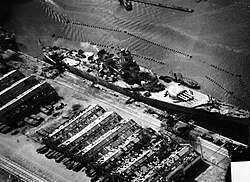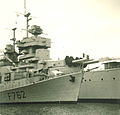Jean Bart (ship, 1940)
|
Jean Bart 1943
|
||||||||||||||||||
|
||||||||||||||||||
|
||||||||||||||||||
|
||||||||||||||||||
|
||||||||||||||||||
The Jean Bart was a French battleship of the Richelieu class from the Second World War . It was named after the privateer Jean Bart . Like her sister ship Richelieu , she also had an eventful history and was only officially put into service in 1949 and only fully completed and equipped in 1955.
history
The Jean Bart was the second ship of the Richelieu class. This was derived from the Dunkerque class battleships built a few years earlier and designed to counter the threat posed by the Italian Navy . Their speed, armor, armament and overall technology were up to date. The unusual quadruple storms were remarkable.
It was laid down in Saint-Nazaire at the Chantiers de Penhoët shipyard in December 1936 and was launched on March 6, 1940. Hardly 75% of it was completed, the engines had never been up and running, and in June 1940 it went to Casablanca , Morocco to escape the advance of the German armed forces in France. Only one of their two 380mm turrets was present. The other, equipped with two instead of the planned four cannons, was loaded onto a cargo ship that was sunk by a German submarine . The 152 mm battery of the middle artillery was also missing and was replaced by anti-aircraft guns.
On November 8, 1942, the French fleet in Casablanca was attacked by US warships and aircraft from the aircraft carrier USS Ranger as part of Operation Torch . The Jean Bart took up action with the USS Massachusetts and received hits from multiple bombs and 406 mm projectiles. On November 10th, much to the amazement of the American crew, she opened fire on the USS Augusta , which thought that the Jean Bart's guns had been silenced. This led the rangers to intervene again . The Jean Bart received two hits from 500 kg bombs, leaked and ran aground. The battle was over in the evening, and the ship surrendered to Free France . As a result, it was proposed to complete the ship in the USA, but that proved impossible because of the too many missing parts. Plans to convert it into an aircraft carrier were approved but discarded. The ship was aground off Casablanca for the next two years.
Use after 1945
The Jean Bart returned to France in 1945 after a temporary repair and was finally completed in 1949 according to a new design influenced by the experiences of the last conflict. In that year it was officially put into service, but it was not finally completed or equipped until 1955.
She took part in the Suez Crisis in 1956 , but was not used as planned for the bombardment of Egyptian cities, as one wanted to avoid the high civilian casualties expected in the event of the attack.
The ship was assigned to the reserve in 1957, decommissioned in 1961 and scrapped in La Spezia (Italy) in 1969 .
photos
Web links
- Caractéristiques principales scheme of a tower (French)
- Photos (French)
- Photo gallery

